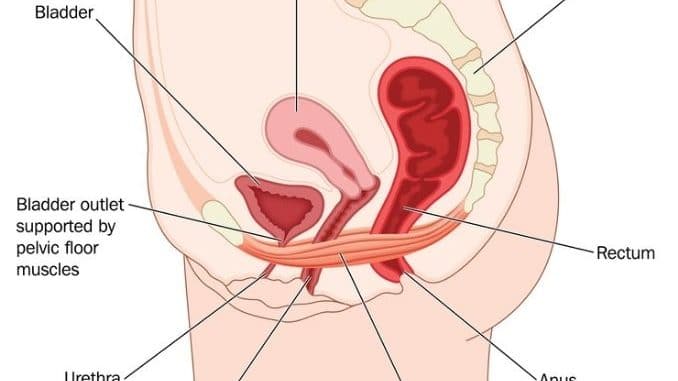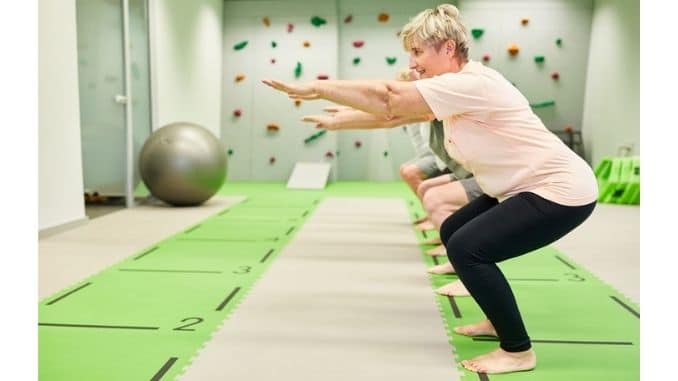
Many people experience subtle changes in their bodies as they age. Some notice urinary leakage, less control over their bowels, or increased urgency to eliminate. While companies that sell incontinence pads will lead you to believe that all of these conditions are normal parts of aging, we’re here to tell you otherwise. The muscles that support your pelvic organs, also known as the pelvic floor, may indeed become weakened as a person ages, gains weight, experiences childbirth, or digestive distress. However, like any other muscle group, the pelvic floor can be successfully strengthened and revitalized. We consulted some expert practitioners in the field of pelvic health rehabilitation to find answers regarding how to strengthen the pelvic floor muscles.
First, since most of us don’t regularly talk about our urinary and bowel muscle groups, let’s define a few of the terms that we’ll be using throughout this article.
- Pelvic Floor – A group of muscles in the lower abdomen that is suspended like a hammock across the bottom of the pelvis. This muscle group supports the pelvic organs (the bowel, bladder, and uterus for women).
- Pelvic Floor Dysfunction – An umbrella term describing any impairment of the pelvic floor muscles
- Incontinence – The partial or complete inability to control the bowel or bladder functions
- Kegel Exercises – Contractions of the pelvic floor muscles recommended to strengthen the muscles for incontinence prevention and to improve sexual functions; named for American gynecologist, Arnold Kegel.

What are some common symptoms of a weak pelvic floor? Some people may have very obvious symptoms of a weak pelvic floor, while others may wonder if what they’re experiencing is even a symptom at all. Here are some signs that you may need to strengthen your pelvic floor:
- You leak a little urine when coughing, laughing or sneezing
- Jumping on a trampoline or certain exercises cause you to leak urine
- You experience pain during or after sexual intercourse
- You have sudden urges to use the restroom and sometimes don’t make it in time
- Using the restroom much more frequently than in the past
- Waking more than twice in the night to use the restroom
- Changing positions (from sitting to standing, squatting, etc) causes an urge to use the restroom or leakage
- There’s a feeling of pressure or heaviness in your pelvic area
- It feels difficult to completely empty your bladder or bowel
- Loss of sensation during sexual intercourse
- Feeling as if you need to strain on the toilet
- Painful urination without another cause
- Lower back pain with no other cause
- Constipation without other causes
- Repeatedly stopping and starting again when urinating
- Muscle spasms in the pelvic region

What causes a weakened or loose pelvic floor? Some people may suffer from pelvic floor dysfunction without any discernible reason. However, there are some factors that can lead to this condition.
- Being heavier than your ideal weight
- Straining while using the bathroom regularly
- Surgery in the pelvic region
- Pregnancy and childbirth
- Injuries to the pelvis
- Heavy lifting
- Coughing spells lasting for months at a time
- Nerve damage
One prevailing myth about pelvic floor dysfunction is that the condition is a normal part of aging. Nonetheless, practitioners who focus on helping their clients overcome these struggles generally disagree. We were able to interview Janet Webber, a physiotherapist in Nova Scotia with 30 years of experience working in pelvic floor rehabilitation. Webber told us, “Pelvic floor dysfunction is a completely treatable problem. It’s a medical condition that can be treated. It isn’t normal for women to pee their pants; it isn’t normal for men to pee their pants. Once we’ve been toilet trained as kids, we shouldn’t have a problem. And if there is a problem, it should be checked out.” Webber also told us that even though women may not experience incontinence until later in life, the condition often occurs because the pelvic floor muscles were not re-strengthened after childbearing.
Webber shared a story about one of her aging clients. “A lady in her eighties was becoming socially isolated and not hanging around people because she feared that she smelled like urine due to her incontinence. Her daughter got her into pelvic floor physiotherapy with me. I think I saw her four times over two months. We worked on some exercises and she got back into life with over 80 percent improvement.” Webber told us she has had numerous older patients who felt that they would just have to endure incontinence because of their age, only to find that they could be free from the condition by strengthening the pelvic floor muscles.

Who needs to strengthen their pelvic floor muscles? Most of the time, men don’t have the same issues as women when it comes to the pelvic floor. The majority of female patients need to strengthen or re-strengthen their pelvic floor muscles. Conversely, when men have pelvic floor dysfunction, they usually need to learn to better relax the muscles in their pelvic floor. In this article, we’ll focus on strengthening the pelvic floor muscles only, which primarily applies to women.
Women who have had a pregnancy or childbirth (vaginal or surgical) should re-strengthen their pelvic floor muscles during and after the pregnancy – even if they have no symptoms of pelvic floor dysfunction. Those who have had any form of surgery in the pelvis should also practice regular strengthening exercises as directed by their healthcare practitioner. Anyone who has been injured in the pelvic area should be examined to determine if strengthening exercises would be helpful as well.
If you are overweight, it’s a good idea to take time regularly to strengthen your pelvic floor. Also, if you engage in intense weight-bearing exercises, have gastrointestinal problems such as irritable bowel syndrome or Chron’s disease, or you’ve had a chronic cough, strengthening your pelvic floor is a good idea.
Strengthening the pelvic floor is extremely important. We also spoke with Kae Etchegoin, President of DK Pilates Academy in Las Vegas, Nevada. Etchegoin says, “The pelvic floor is one of the most important muscle groups of the entire body. When you look at the core as a house, the diaphragm is at the top and makes the roof of the house. The walls of the house are the transverse abdominal muscles and the bottom, or the foundation of the house is the pelvic floor muscle group. If the pelvic floor is not stabilized, the house doesn’t stand up.”
Locate your pelvic floor muscles. Etchegoin helps her pilates clients locate this muscle group so that they can effectively perform strengthening exercises. She said, “Often people think they are doing pelvic floor exercises when they are contracting their gluteal muscles instead.”
Etchegoin uses a rolled-up hand towel placed longways on a chair. Then she has her client sit on the chair with the towel in between their legs, parallel with the client’s legs. The muscles that are in contact with the towel are the muscles of the pelvic floor. Etchegoin says, “As they exhale, I have them draw their belly button to the spine and squeeze the towel. The client is then using the pelvic floor muscles to squeeze the towel. After the towel is removed, they can repeat the exercise and contract the correct muscles.”
- When you stand up, you pull up. Webber also shared one of the exercises she recommends to nearly all of her clients who need to strengthen their pelvic floor muscles. She tells her patients to tighten their pelvic floor muscles every time they stand up from a sitting position. Webber says, “When you move from a sitting to a standing position, you will naturally feel a contraction in the pelvic floor as you stand. All you do is increase that natural contraction and tighten the muscles around your pelvic organs each time you stand.”
- Use a soft squeezable ball. Another exercise that Etchegoin employs is a softball squeeze. Etchegoin says, “The pelvic floor is connected to the inner thighs. I have my client sit at the edge of a chair and put a softball, about eight inches in diameter, in between their upper, inner thighs and squeeze the ball. As they squeeze the ball, they will also squeeze the pelvic floor muscles.”

- Kegel exercises are also helpful. Kegel exercises are often recommended when people need to strengthen their pelvic floor muscles. Webber recommends Kegel exercises to many of her clients. According to Medical News Today, “Doctors often recommend Kegel exercises as a means to strengthen the muscles that support the bladder and keep it closed. This can improve a person’s ability to start and stop their urine stream.”
To perform Kegal exercises, contract your pelvic floor muscles and hold them for three seconds. Release the muscles. Then repeat this 10 times, twice a day. As your muscles get stronger, you should increase the frequency to 20 repetitions, then up to 50 repetitions, three times a day. You can also increase the intensity of the exercise by holding the contraction for five seconds at a time.

- Squat. Squats are quite helpful for several muscle groups in the body, including the pelvic floor. Start by standing with your feet slightly wider than shoulder-width apart and your toes pointed slightly outward. Bend your knees and shift your seat and hips back, like you’re going to sit down on a chair. Squat down until your thighs are parallel to the floor, keeping your weight on your heels. Then straighten your legs as you return to a standing position. Start out with 10 squats, three times a day. Increase your frequency to 20, then 30 or more as you become stronger.
Strengthen your pelvic floor while you’re waiting. Many of the simple exercises we use to strengthen the pelvic floor can be done throughout the day while you’re waiting or performing other tasks. Webber says, “You could be tightening while you’re doing the dishes, sitting in traffic, or brushing your teeth. You want to do these exercises frequently throughout the day.” She jokingly added that you should make sure you’re sitting at a stoplight if you do these exercises in traffic, as a stop sign isn’t long enough.
Note: If you feel pain or soreness in the abdominal muscles or your back after you’ve engaged in pelvic floor strengthening exercises, that’s a sign that you may be performing the activities incorrectly. Schedule an appointment with a physiotherapist for further instruction.
You’ll see results with continual practice. Webber says that you can expect to see some improvement in your pelvic floor muscles after about four to six weeks of regular daily strengthening exercises, and dramatic improvement after six months.
There is no level of incontinence that we just have to endure as we age. A weak pelvic floor is a medical condition that can be successfully treated in the vast majority of cases. Use these exercises and ideas to strengthen your pelvic floor and enjoy an active, quality lifestyle.
Looking for a safe and gentle way to strengthen your pelvic floor muscles? Try our program below.

